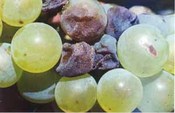 I’ve been reading a few stories locally about how "great" the 2006 vintage is looking here on Long Island. Of course, knowing that the authors of these stories don’t typically cover wine (if ever) I was skeptical. It’s been very wet and humid lately and we’ve had several days where we’ve touched 90 degrees.
I’ve been reading a few stories locally about how "great" the 2006 vintage is looking here on Long Island. Of course, knowing that the authors of these stories don’t typically cover wine (if ever) I was skeptical. It’s been very wet and humid lately and we’ve had several days where we’ve touched 90 degrees.
But, rather than make assumptions, I asked Richie Pisacano, owner of Roanoke Vineyards and vineyard manager at Wolffer Estate for an update on what he’s seeing. He’s been growing grapes on Long Island a long time, and he’s not one to fall victim to marketing/PR spin.
This is his response and update on the 2006 growing year on Long Island:
"The problems are widespread in the vineyards this year. Disease pressure is high with long periods of wetness and high humidity. Moisture and temperatures in the 70-80 range are the enemy. And, when sunlight is low, disease gets the healthy enviroment it needs. Sunlight can difuse disease to a degree.
This year we had a rainy bloom time and lack of sunlight, so powdery mildew (grape killer) was reportedly high in vineyards that you would not expect to see. Downy mildew (foliage killer) has been a problem as well.
When you get infections early (bloom period) It is a problem for the rest of the year because you can have explosions later on with residual infections under the right conditions…more rain, more humidity.
Also powdery mildew penetrates the surface of the berry so even if you kill the mildew, your berries are much much more susceptible to botrytis and nasty molds I cannot even name.
Plus, when it rains, off comes the material that you sprayed on. The question becomes, how much washed off? How soon should I re-apply? Now with the extreme pressure, it is more important to take leaves away from fruit and hedge and keep the vine open in order to keep moisture from trapping and problems festering, which make more work.
As you know, to get the extra ripening, we need a healthy canopy to produce those things that constitute ripeness. Without green leaves, it is likely that full maturity will not be reached. This is why the whites are more forgiving with the current style. You do not have to go the whole distance.
With most reds it is more important. With unripe reds words like "light" and "green" but with unripe whites vibrant, clean and tasty aren’t always so bad."
